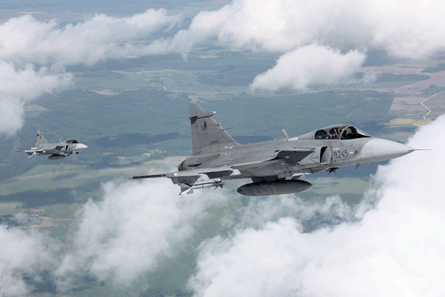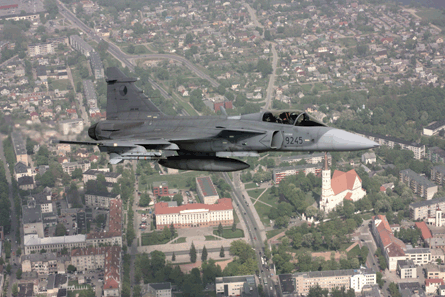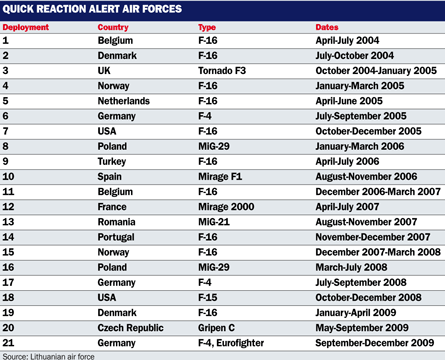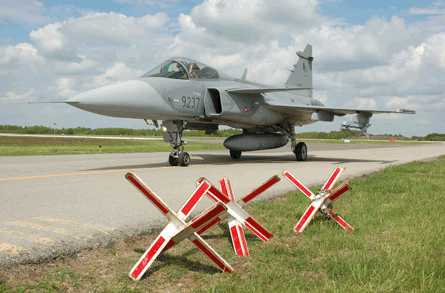NATO's most recent expansion, in March 2004, included Baltic states Estonia, Latvia and Lithuania, which were collectively unable to defend their airspace from potential threats. The duty of providing air policing, or quick reaction alert (QRA) cover for the nations' 6.8 million inhabitants fell upon the wider NATO community, which is expected to maintain its commitment until around 2018.
Flight International visited Lithuania's Siauliai air base as the fourteenth nation to assume the Baltic QRA mission was less than three weeks into its four-month detachment at the site. Notably for the Czech Republic, the first operational overseas deployment to have been undertaken by its air force since joining NATO in 1999 is also the first commitment of its kind made by Prague since the end of the Second World War.
Equipped with four Saab Gripen C fighters, the current detachment is drawn from the Czech air force's 211th Tactical Squadron, home based at Cáslav, around 80km (43nm) east of the nation's capital.
 |
|---|
© Lt Col David Schreier/Czech air force |
Two of the aircraft have been held at readiness to take off within 15min on a 24h, seven-day-a-week basis since 1 May, with the commitment forming part of the wider NATO Integrated Air Defence System. Armaments carried for the Baltic mission are two Raytheon AIM-9M Sidewinder short-range air-to-air missiles and typically around 100 gun rounds per aircraft.
The deployment is notable not only for its historic-first nature, but also because the Czech air force only began operating the Gripen in 2005 under a 10-year lease deal brokered via Sweden's Defence Materiel Administration (FMV).
In addition, despite having a total of just 12 Gripen Cs and two D-model operational trainers, the service is providing parallel QRA cover for the Czech Republic from Cáslav.
"As one squadron we are supporting two QRAs, so you can imagine the people are busy now," says Czech air force Maj Jaroslav Míka, detachment commander for the Baltic mission and also Gripen squadron commander. The fleet logged more than 6,000 flight hours in its first three years of use, according to Saab.
 |
|---|
© Lt Col David Schreier/Czech air force |
Preparations for the Lithuanian deployment started in February 2007, with an initial base survey having been conducted later the same year. Materiel preparation work began last October, with a second site survey conducted in February. "We are not an experienced nation with sending our tactical aircraft abroad," notes Míka.
Czech personnel and Gripens had previously been deployed to Norway, Poland and Turkey for training, and squadron personnel performed a six-month work-up ahead of the Baltic deployment, following a model used by Czech military personnel deployed to Afghanistan and Iraq.
EVALUATION EXERCISE
Final preparations included an air policing evaluation exercise conducted at Cáslav from 9-13 March, which assessed the unit's standards, techniques and procedures against NATO guidelines. The process included support from Czech air force Aero Vodochody L-159 advanced light combat aircraft, plus transports and helicopters.
The first Czech aircraft arrived at Siauliai on 30 April, with the presence to continue until the German air force takes over responsibility for the QRA mission on 1 September (see box).
Representing the 20th period of cover to have been provided to the Baltic states, the Czech detachment has already been called upon for the first time. A so-called "Alpha" scramble intercept was launched on 21 May, after a civilian aircraft was detected flying along the Russian-Lithuanian border after departing Poland.
"A signal informing about an A-Scramble rang at 17:30. Our pilots were airborne at 17:41 and intercepted a German-registered aircraft at 17:50," says Lt Col David Schreier, liaison officer of the Czech air policing detachment. Restricted from approaching within 1,000ft (305m) of the potential threat, the Gripens monitored the aircraft until it landed at Lithuania's Klaipeda airfield, before they returned to Siauliai.
"We learnt the day after that the aircraft had had a flight plan through that area, but it was not activated by the Brussels flight co-ordination centre," says Schreier. Typical of most recent incidents, the event was the first in several months over the Baltic states: the previous Danish Lockheed Martin F-16 contingent did not conduct an Alpha scramble during its entire tour of duty. US Air Force Boeing F-15s were twice launched from Siauliai between October and December 2008.
 |
|---|
Gripens are launched around 10 times a year in the Czech Republic to investigate irregular flight activity, says Míka.
A total of 75 Czech personnel are participating in the Baltic mission, with the majority of these to be rotated half-way through the commitment. The total includes eight pilots and 36 maintenance and logistics personnel at Siauliai and some personnel assigned to a Lithuanian command and control facility at Karmelava.
The mission is planned to total around 290 flying hours and not more than 350 by September, with the latter limit having been established to avoid adversely affecting operations at Cáslav. The air force usually has eight of its 12 Gripen Cs ready for operations each day, and detachment maintenance and logistics officer Maj Pavel Buchta notes: "What you do now, you will see the results 18 months from now."
The planning assumption is for the detachment to fly eight two-aircraft training missions - or Tactical scrambles - a week, up to a maximum of 8h a day and 25h a week. No training sorties are flown at weekends due to local noise restrictions, although the 15min QRA cover is maintained.
As its existing Gripen deal only covers the support of aircraft operating at their home base, Prague has signed a supplemental deal with the FMV to enable its Baltic duties. This covers some additional spare parts, line replaceable units and ground support equipment delivered to the Czech Republic, from where one logistics flight is performed to Siauliai each week using an air force Antonov An-26 transport.
 |
|---|
© Craig Hoyle/Flight Interntational |
"Our main ground support equipment and resources are at our home base, and we had to be prepared to fly from an almost bare base," says Buchta, who describes the mission as "the biggest challenge in my career".
Around 80% of the squadron's equipment arrived in Lithuania by road, while more sensitive and hazardous supplies, such as ammunition and missiles, were flown in by An-26. "We have limited airlift resources in the Czech Republic, which is not so good for a detachment abroad," says Buchta. However, its air force will later this year receive the first of four Airbus Military C-295 transports under a deal announced during May.
MAINTENANCE WORK
Minor maintenance and repairs are conducted at Siauliai, while larger activity, such as technical services scheduled after every 200 flight hours and lasting between four and six weeks, are conducted in the Czech Republic.
The aircraft had logged 72h in 48 sorties by 19 May, and Míka says: "We haven't had any major maintenance issues; we keep four aircraft in flying condition." He praises the Gripen's on-board diagnostics system, noting: "Straight after landing you know what it is necessary to maintain."
Some Swedish support personnel are also based at Cáslav under the lease deal, and the air force brought two of these to Siualiai at the start of the detachment. But in a sign of the squadron's independence they soon returned to the Czech Republic. "There was nothing for them to do," says Míka. "We are doing well," adds Buchta. "It was good preparation, and we have found solutions to problems."
TRAINING SCRAMBLES
Czech pilots are managing to conduct some training during Tactical scrambles, for example flying with Lithuanian air force Aero Vodochody L-39s or Mil Mi-8 transport helicopters. However, these are largely limited to flying 2:1 scenarios, says Míka. Visiting pilots are also making use of the mission's protected airspace over the Baltic Sea, which offers a different training experience to the land-locked Czech Republic.
The last Gripen will leave Lithuania on 4 September for its 80min return flight to Cáslav - a distance of almost 1,040km (560nm).
Although the detachment is stretching the Czech air force's small fleet of fighters and testing its aged air transport fleet, the experience is an important one for a country just a decade into its NATO experience. The detachment is also a welcome opportunity for its fighter pilots - capped at flying an average of 150 flight hours a year at home - to taste deployed operational life for the first time.
- Next week: read our programme update on the Gripen and its future sales prospects
Source: Flight International























